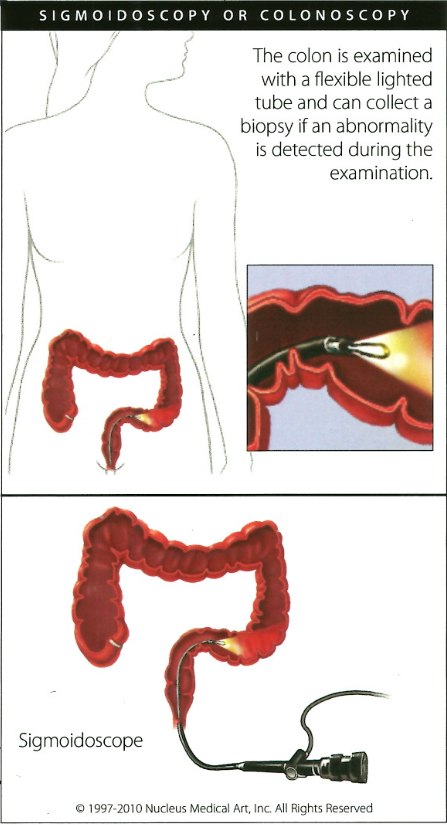What is colonoscopy?
a colonoscopy allows a doctor to look inside the entire large intestine. The procedure enables. the physician to see things such as inflamed tissue, abnormal grwths, and ulcers. it is most often used to look for early signs of cancer in the colon and rectum. it is also used to look for causes of unexplained chan ges in bowel habits and to evaluate symptoms like abdominal pain, rectal bleeding, and weight loss.
What is the colon?
the colon, or large bowel, is the last portion of your digestive tract, or gastrointestinal tract. The colon is a hollow tube that starts at the end of the small intestine and ends at the rectum and anus. the colon is about 5 feet long, and its main function is to store unasbsorb food waste and absorb water and other body fluids before the waste is eliminated as stool. Cleansing of the bowel is necessary before colonoscopy. You will likely be asked to take a laxative the night before the procedure. inform your doctor of any medical conditions you have or medications you take on a regular basis such as aspirin, arthritis medications, blood thinners, diabetes medications, and vitamins that contain iron. The medical staff will also want to know if you have heart disease, lung disease, or any medical condition that may need special attention. You must also arrange for someone to take you home afterward, because you will not be allowed to drive after being sedated.
Procedure
For the colonoscopy, you will lie on your left side on the examination table. You will be given pain medication and a moderate sedative to keep you comfortable and help you relax during the exam. The doctor and a nurse will monitor your vital signs, look for any signs of discomfort, and make adjustments as needed. The doctor will then insert a long, flexible, lighted tube into your rectum and slowly guide it into your colon. The tube is called colonoscope. The scope transmits an image of the inside of the colon onto a video screen so the doctor can carefully examine the lining of the colon. The scope bends so the doctor can move it around the curves of your colon.
The scope blows air into your colon and inflates it, which helps give the doctor a better view. Most patients do not remember the procedure afterwards.
The doctor can remove most abnormal growth in your colon like polyp, which is a growth in the lining of the bowel. Polyps are removed using tiny tools passed through the scope. Most polyps are not cancerous, but they could turn into cancer. Just looking at a polyp is not enough to tell if it is cancerous. The polyps are sent to a lab for testing. By identifying and removing polyps, a colonoscopy likely prevents most cancers from forming.
The doctor can also remove tissue samples to test in the lab for diseases of the colon (biopsy). In addition if any bleeding occurs in the colon, the doctor an pass a laser, heater probe, electrical probe, or special medicines through the scope to stop the bleeding. The tissue removal and treatments to stop the bleeding usually do not cause pain. In many cases, a colonoscopy allows for accurate diagnosis and treatment of colon abnormalities without the need for major operation.
When the doctor has finished, the colonoscope is slowly withdraw while the lining of your bowel is carefully examined. Bleeding and puncture of the colon are possible but uncommon complications of a colonoscopy.
Colonoscopy usually takes 30 – 60 minutes. The sedative and pain medicine should keep you from feeling much discomfort during the exam. Rarely some people experience severe abdominal pain, fever, bloody bowel movements, dizziness, or weakness afterward. If you have any of these side effects, contact your physician immediately. Read your discharge instructions carefully. Full recovery by the next day is normal and expected and you may return to your regular activities.
Taking Steps to Prevent Colon Cancer
Maria Casas Colonoscopy Procedure. Source KGNS Laredo TX. by Michelle Pedraza
LAREDO, Texas (KGNS) – It’s something you may not look forward to but a colonoscopy could save someone’s life.
Over 150,000 people are diagnosed with colon cancer every year, but detecting it early takes less than 30 minutes.
Mari Casas was nervous about undergoing her procedure. Casas turned 51 which is the recommended age for patients to receive the screening. Maria was put on a liquid diet in preparation of her colonoscopy in order for the intestines to be completely cleared out.
Before starting she received an anesthetic and was put to sleep, the colonoscope is a thin tube with a camera attached is placed inside her, allowing the doctor to look through her intestine. Also the doctor makes sure to check for polyps, or a benign growth along the ligning of the colon. At the end of the procedure, three polyps were found and removed.
The doctors recommended her to receive her next colonoscpy in the next five years.
In the past ten months, the center has detected colon cancer in 15 of their patients, four of those were diagnosed in just the last six weeks.

